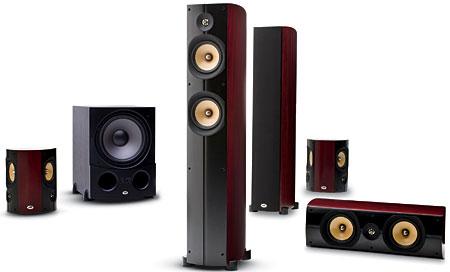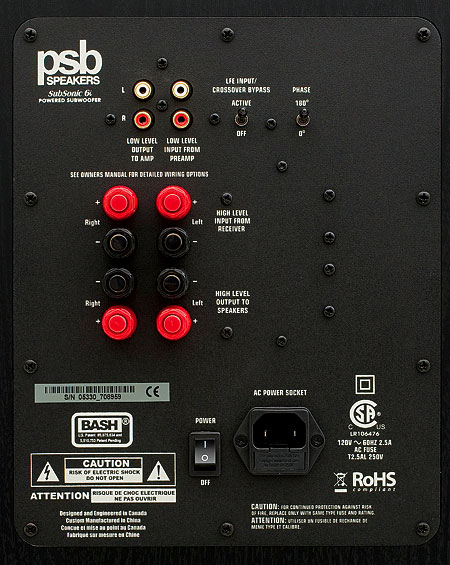PSB Imagine T Speaker System

At A Glance: Open, clean, and detailed • Expansive, cinematic sound • High value
Imagine: Airy Soundscapes
When deciding whether or not to set product priority for evaluation, every reviewer (consciously or unconsciously) applies a filter based on his or her previous experience with that manufacturer. Of course, there are always breakthrough products that demand to be covered and new companies that deserve to be discovered. But given the options available in the speaker world—including the new and the fascinating but rarely the revolutionary—you look first to those that have proved that they can make a great product.
Canadian manufacturer PSB falls solidly into that category. Thirty-seven years ago, Paul Barton founded the company with his wife Sue (PSB is Paul and Sue Barton). There may be a smoldering pile or two of drivers and sawdust somewhere in PSB’s past, but if there is, they certainly never got past the R&D stage.
The Imagine line is Barton’s new baby. It’s one step down from last year’s well-received and still current flagship, the Synchrony series. Like many of today’s speakers, the Imagines are manufactured in China. But PSB does the engineering, which makes extensive use of the testing facilities and anechoic chamber at Canada’s National Research Council.
Imagination
The Imagine line contains four models, three of which are included in this review system: the Imagine T, Imagine C, and Imagine S. As you can, um, imagine, the letters T, C, and S stand for tower, center, and surround.
There is no dedicated Imagine subwoofer, so PSB sent along its SubSeries 6i. It’s a rather conventional design in a plain-Jane, black-vinyl-finished cabinet. Inside, it has a single 12-inch driver with dual, front-mounted ports and a 225-watt (continuous) BASH amplifier. There’s also a line-level output with a fixed 80-hertz, 12-decibel-per-octave high-pass filter, an adjustable crossover that utilizes a 24-dB-per-octave, Linkwitz-Riley low-pass filter, and a 0- or 180-degree phase switch. The low-pass crossover (variable from 50 to 150 Hz) and level controls are conveniently located on the front of the cabinet. You can bypass the crossovers for use with the crossover in an A/V receiver or surround processor. The SubSeries 6i also provides speaker-level inputs and outputs.
The SubSeries 6i may be an aesthetic wallflower, but the Imagines are definitely not. The first thing that strikes you about them is their beautifully styled cabinetwork, which is finished in handsome wood veneer. But their looks are only half the story. All of the Imagines have solidly built enclosures, with heavy internal bracing and thick front baffles, smoothly rounded to minimize diffraction.

At the action end, all of the Imagines utilize one or two of PSB’s newly designed 5.25-inch woofer-midrange drivers. Their light, stiff, well-damped cones are fabricated from ceramic-filled polypropylene. The aluminum phase plug (visible at the center of the cone in place of the usual dust cap) is a technical design feature that the Imagine borrows from the Synchrony line. The company says it reduces distortion and increases linearity at higher frequencies. The entire Imagine line uses the same 1-inch titanium-dome tweeter with a neodymium magnet structure.
The passive crossovers are all (acoustical) fourth-order Linkwitz-Riley. The dual binding posts (which you may use strapped together or separated for biwiring or biamping) accept bare wire up to 10 gauge, spades, or banana plugs (single or dual). To use bananas, you can easily remove the Euro-nanny plastic plugs that are installed in the terminal holes. The plugs are there to keep clever but clueless continentals from blowing up their speakers by connecting them directly to European-style, 220-volt electrical outlets.
The Imagine T employs two of the Imagine line’s woofer midranges in a 2.5-way configuration. Both operate in the bass up to 800 Hz, and the uppermost driver alone continues up to the 1,800-Hz tweeter crossover. The Imagine C center is a straight two-way design. Its two woofers operate together up to the 1,800-Hz handoff to the tweeter.
Both the Imagine T and Imagine C are ported (the Imagine T has two ports, while the Imagine C has one). You can use the provided plugs to fine-tune the bass, to a degree, by stopping up the port on the Imagine C and/or either of the ports on the Imagine T. The optimum port-plug configuration will depend on your room, setup, and subwoofer.
The Imagine S surround uses two angled sets of drivers (a woofer and tweeter on each opposing baffle). You can wire it in a number of ways. In a conventional 5.1-channel system, you can drive it either as a bipole, with the two sets of drivers in phase, or a dipole, with them wired out of phase to produce a center null. For a 7.1-channel system, you can split the two sets of drivers. You can use one set for the side surrounds, while the other, reflecting off the back wall, acts as rear surrounds. You can even use three or four of them in additional ways—your PSB dealer won’t object. I used a single pair as dipoles.
Imagining Music
When I auditioned the left and right Imagine Ts in two channels, along with the SubSeries 6i crossed over at 80 Hz, the system sounded as impressive as it looks. Its third-octave measurements, taken at the center listening seat located about 11 feet from the speakers, indicated an unusually smooth in-room response. The output at 16 kilohertz was down about 10 dB from the output at 30 Hz, and the drop-off was gradual and extremely uniform from bottom to top. I conducted all of my auditions and measurements with the grilles removed.
Many experts recommend a down-sloping response at the listening position, depending on measurement technique. Some listeners might prefer a somewhat shallower tilt, but the Imagine T’s spectral balance (which will vary in different rooms) was in no way dull. Refined, yes, but plenty detailed. From the delicate sound of brushed cymbals to the snappy thwack of aggressively played guitar, the highs were all there. They were never over the top, aggressive, or “I am tweeter, hear me roar!” on program material of known high quality.
From those open highs on down, the performance remained strong. The Imagine’s small drivers produced a clear, uncolored midrange. Imaging was tightly defined, and depth, if present in the recording, was convincing.
Apart from the lowest organ notes, the SubSeries 6i handled every musical challenge I threw at it. I haven’t reviewed many subs that cost less than $1,000, but if I hadn’t already known the SubSeries 6i’s price, I would not have guessed that it sells for considerably less than that. Its looks may be unassuming, but its performance is not. It has limitations to be sure, particularly at the extreme bottom end (more on this in the movie section, below). Your room and setup will definitely have more influence on the SubSeries 6i’s performance than the sub’s inherent limitations.
- Log in or register to post comments





































































